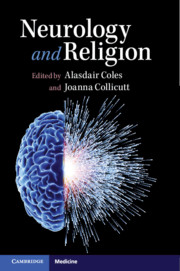Book contents
- Neurology and Religion
- Neurology and Religion
- Copyright page
- Contents
- Contributors
- Preface
- Part I The Neurological Study of Religion
- Part II Neurology and Religion
- II.I Clinical Conditions
- Chapter 9 Temporal Lobe Epilepsy, Dostoyevsky and Irrational Significance
- Chapter 10 Parkinson’s Disease, Religious Belief and Spirituality
- Chapter 11 Beyond Reasonable Doubt
- Chapter 12 Ramadam Fasting and Neurologic Disorders
- Chapter 13 Autism and the Panoply of Religious Belief, Disbelief and Experience
- Chapter 14 Personhood and Religion in People with Dementia
- Chapter 15 Religion and Frontotemporal Dementia
- II.II Therapy
- II.III Death and the Brain
- Bibliography
- Index
- References
Chapter 10 - Parkinson’s Disease, Religious Belief and Spirituality
from II.I - Clinical Conditions
Published online by Cambridge University Press: 28 October 2019
- Neurology and Religion
- Neurology and Religion
- Copyright page
- Contents
- Contributors
- Preface
- Part I The Neurological Study of Religion
- Part II Neurology and Religion
- II.I Clinical Conditions
- Chapter 9 Temporal Lobe Epilepsy, Dostoyevsky and Irrational Significance
- Chapter 10 Parkinson’s Disease, Religious Belief and Spirituality
- Chapter 11 Beyond Reasonable Doubt
- Chapter 12 Ramadam Fasting and Neurologic Disorders
- Chapter 13 Autism and the Panoply of Religious Belief, Disbelief and Experience
- Chapter 14 Personhood and Religion in People with Dementia
- Chapter 15 Religion and Frontotemporal Dementia
- II.II Therapy
- II.III Death and the Brain
- Bibliography
- Index
- References
Summary
Whether the experience, symptoms, treatment or neuropathology of Parkinson’s disease (PD) could potentially play a role in shaping religious beliefs and practices can be viewed from several different angles. For example, a diagnosis of a serious illness could make one reassess and question previously held attitudes and beliefs; faith in a benign God may be challenged. Spirituality, broadly defined as a quest for meaning and truth, could also play a role in the process of integrating the experience of living with Parkinson’s disease, as with any disease or major life experience. Less conscious mechanisms might also be in play, more intrinsic to the disease process, such as loss of motivational drive due to dopaminergic dysfunction. The resulting apathy, which is often seen in PD, might reduce efforts to pursue personal interests, including a religious faith. Cognitive deficits, for example altered social cognition such as changes in ‘theory of mind’, could also potentially contribute. At a more pragmatic level, problems with decreasing mobility, and energy levels as well as a host of other symptoms and drug side-effects could potentially make all aspects of daily life problematic, therefore impeding the pursuit of religious practices or a spiritual path. In this chapter we review and discuss the existing literature and research, in the hope that it might augment understanding of this little-studied aspect of PD as well as contribute to cognitive perspectives on religious belief and experience.
- Type
- Chapter
- Information
- Neurology and Religion , pp. 101 - 114Publisher: Cambridge University PressPrint publication year: 2019
References
- 1
- Cited by



